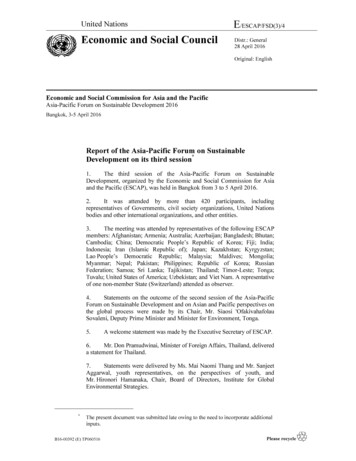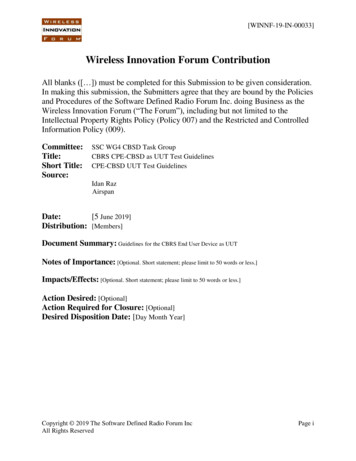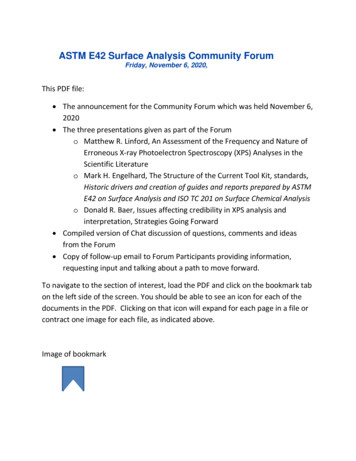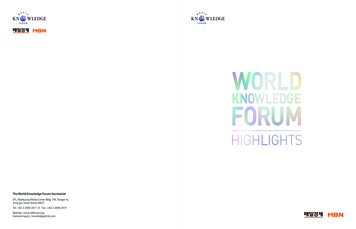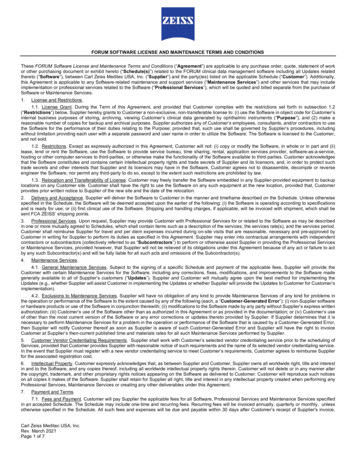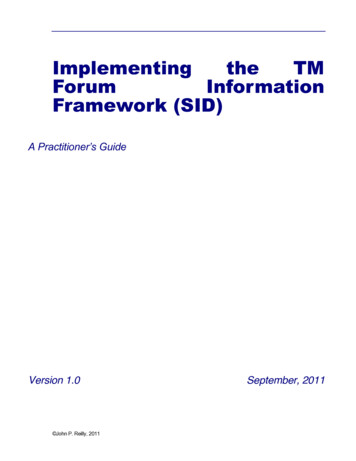
Transcription
ImplementingtheTMForumInformationFramework (SID)A Practitioner’s GuideVersion 1.0 John P. Reilly, 2011September, 2011
Implementing the TM Forum Information Framework (SID): A Practitioner’s GuideBy John P. ReillyCopyright 2011 John P. ReillyAll rights reserved. No part of this book shall be reproduced, stored in a retrieval system, ortransmitted by any means, electronic, mechanical, photocopying, recording or otherwise withoutwritten permission from the publisher. No patent liability is assumed with respect to the use of theinformation contained herein. Although every precaution has been taken in the preparation of thisbook, the publisher and authors assume no responsibility for errors or omissions. Nor is any liabilityassumed for damages resulting from use of the information contained herein.This book is sold subject to the condition that it shall not, by t way of trade or otherwise, be lent,resold, hired-out, or otherwise circulated without the publisher’s prior consent in any form of bindingor cover other than that in which it is published and without a similar condition including this conditionbeing imposed on the subsequent purchaser.Published by TM ForumFirst printing: [insert printing date]ISBN [insert ISBN number]TrademarksAll terms mentioned in the book that are known to be trademarks or service makes have beenappropriately identified. The publisher cannot attest to the accuracy of this information. Use of aterm in this book should not be regarded as affecting the validity of any trademark or service mark.Warning and DisclaimerEvery effort has been made to make this book as complete and accurate as possible, but nowarranty or fitness is implied. The information provided is an “as is” basis. The authors and thepublisher shall have neither liability nor responsibility to any person or entity with respect to any lossor damages arising from the information contained in this book. John P. Reilly, 2011Page i
Implementing the TM Forum Information Framework (SID): A Practitioner’s GuideVersion 1.0John P. Reilly, 2011Page ii
Table of ContentsTable of Contents. iiiList of Figures. viAcknowledgements . 1Preface . 2Chapter 1 – The Information Framework (SID) . 3The Information Framework (SID) . 3The SID’s Structure. 4The SID UML Model . 8Extensibility of the SID . 9Chapter 2 – Implementing SID Patterns . 13Class Hierarchy Implementation Techniques . 13Class Hierarchy Technique Guidance. 20Class Hierarchy Implementation Considerations . 22Implementing Other Modeling Patterns . 25EntitySpecification/Entity . 25Entity/EntityRole. 26CharacteristicSpecification/CharacteristicValue . 27Chapter 3 – SID and Database Design. 29A Note on SID and Database Design . 29Database Design & Class Hierarchy Patterns. 29General Considerations. 29Top Down – Business Interaction Pattern . 31Bottom Up – Composite/Atomic Pattern. 35Middle Up & Down (Top Down, Bottom Up). 41Database Design & Other Modeling Patterns . 42EntitySpecification/Entity . 42Entity/EntityRole. 42CharacteristicSpecification/CharacteristicValue . 47Working with Other SID ABEs . 52Working with Base Type ABE Entities. 52Implementing the Contact Medium ABE . 54Implementing the Location ABE . 56Version 1.0John P. Reilly, 2011Page iii
Implementing the TM Forum Information Framework (SID): A Practitioner’s GuideVersion 1.0Lessons Learned . 59Information Model Considerations. 59Database Design Tool Considerations. 60John P. Reilly, 2011Page iv
Version 1.0John P. Reilly, 2011Page v
Implementing the TM Forum Information Framework (SID): A Practitioner’s GuideList of FiguresFigure 1.01- SID Domains6Figure 1.02 – SID Level 1 ABEs7Figure 1.03 – SID Level 2 ABEs8Figure 1.04 – Customer UML Model9Figure 1.05 – SID as a Framework of Frameworks10Figure 2.01 – Consolidating Sub-Classes – Top Down - Before14Figure 2.02 – Consolidating Sub-Classes – Top Down - After15Figure 2.03 – Consolidating Sub-Classes – Bottom Up - Before15Figure 2.04 – Consolidating Sub-Classes – Bottom Up - After16Figure 2.05 – Consolidating Sub-Classes – Top Down – Bottom Up - Before17Figure 2.06 – Consolidating Sub-Classes – Top Down – Bottom Up - After18Figure 2.07 – Consolidating Sub-Classes – Typing - Before19Figure 2.08– Consolidating Sub-Classes – Typing - After19Figure 2.09 – Performance Management Class Hierarchy20Figure 2.10 – Transformed Performance Management Class Hierarchy20Figure 2.11 – Product and Inventory Performance20Figure 2.12– Usage Class Hierarchy21Figure 2.13 – Transformed Usage Class Hierarchy21Figure 2.14 - Service Hierarchy - Bottom Up - Before24Figure 2.15 – Service Hierarchy – Bottom Up – After24Figure 2.16 – Party and PartyRole26Figure 2.17 – PartyRoles Transformed Into Party Subclasses26Figure 3.01 – Customer Order Logical Data Model Fragment31Figure 3.02 – Transformed Customer Order Model Fragment32Figure 3.03 – Customer Order Inherited Associations33Figure 3.04 – Product Offering UML Model Fragment35Figure 3.05 – Product Offering Logical Data Model36Figure 3.06 – Product Offering Physical Data Model37Figure 3.07 – Customer Without Party Role42Figure 3.08 – Partial PartyRole and Customer Logical Data Model43Figure 3.09 – Partial Party, PartyRole, and Customer Physical Database43Figure 3.10 – Customer Logical Data Model44Version 1.0John P. Reilly, 2011Page vi
Figure 3.11 – Customer Physical Data Model45Figure 3.12 – Details of Customer Physical Data Base Entity47Figure 3.13 – Basic Characteristic and “Use” Entities48Figure 3.14 – Full Characteristic Specification Model48Figure 3.15 – Product Specification “Use” of Characteristics49Figure 3.16 – Product Specification and Characteristic Keys50Figure 3.17 – Example Physical Entity with Columns and All Keys50Figure 3.18 – TimePeriod as a Related Entity52Figure 3.19 – Time Period Attributes Transformed As Attributes53Figure 3.20 – Contact Medium Logical Data Base Model54Figure 3.21 – Contact Medium Physical Data Model55Figure 3.22 – Urban Property Addresses Logical Data Model56Figure 3.23 – Postal Delivery Address Logical Data Model57Figure 3.24 – Address Physical Data Model58Figure 3.25 – SID Product Offering ABE59Figure 3.26 – Structure Compare of Two Physical Data Models61Version 1.0John P. Reilly, 2011Page vii
Implementing the TM Forum Information Framework (SID): A Practitioner’s GuideAcknowledgementsWhen the number of books about TM Forum deliverables, such as Frameworx Distilled,reached five, I thought I was done. But then I started thinking about the members whohave often asked about using the Information Framework (SID) as a starting point fordatabase development. And, a few other SID-related topics. So, I thank you all forproviding me with the inspiration to write a sixth and perhaps final book, at least from me!I would like to thank the TM Forum, which permitted the use of content from various SIDdocuments and models. And, to IBM who have kindly provided licenses to me for theuse of Rational Software Modeler and InfoSphere Data Architect.I can’t forget thanking my wife, Jeannie, who puts up with my crazy traveling scheduleand the somewhat odd hours I work during my time at home with her and Sara the cat.John P. ReillyVersion 1.0John P. Reilly, 2011Page 1
Implementing the TM Forum Information Framework (SID): A Practitioner’s GuidePrefaceThe adoption of the TM Forum’s Information Framework (SID) continues to increasewithin the information, communications, and entertainment industry. As a result, there isa need to provide advanced guidance on how the SID can be implemented by TMForum members. Specifically, members expect guidance on implementing the SID foruse in interface specifications as well as database design.This book introduces more advanced concepts/techniques that can be used tosuccessfully implement the SID within an application environment. They have beengathered and used by many SID practitioners from both teaching and consultingengagements. The culmination of this experience resulted in the practical guidancepresented here for using the SID from an implementation perspective. Examples areused throughout the book to demonstrate the concepts and techniques presented.In addition to providing an overview of the SID, this book’s chapters provide guidancefor:Implementing SID modeling patternsSID and database designMaintaining SID conformanceInstantiating SID entitiesApplying other implementation considerationsVersion 1.0John P. Reilly, 2011Page 2
Implementing the TM Forum Information Framework (SID): A Practitioner’s GuideChapter 1 – The Information Framework (SID)This chapter provides an overview of the SID, focusing on the its benefits, its structure,and its inherent extensibility.The Information Framework (SID)The Information Framework (SID) responds to the industry need for a shared informationand data model. It represents an enterprise-wide information decomposition and model.An information model is independent of platform, language and protocol – today theInformation Framework is an information model. One single information model can beused as the starting point for multiple technology-specific data models, such astechnology-specific databases and technology-specific interfaces.As a federated model, the SID draws on knowledge from other industry associations,standards bodies, authorities, and TM Forum member companies;; it is not “homegrown”. The origins of the SID come from member contributions as well as existingindustry models, such as ITU-T M.3100 and Distributed Management Task Force(DMTF) Common Information Model (CIM).The reasons for having an information model are also relevant from a shared informationarchitecture perspective. The SID is one of the few industry models that cover thebreadth of an entire enterprise. The SID provides a standard way of structuring,defining, and implementing information and also provides consistent, commonterminology.The model includes all concepts typical of an object-oriented model with the exception ofbehavior, or how things work. Behavior is provided not only by services and interfacesthat make up the Integration Framework, but also the Process Framework, which alsorepresents behavior.The Information Framework, specifically Product and Service related entities, are now anITU-T standard as of July 2008.The framework assists in achieving a number of benefits:Reduce time to marketReduce cost of integrationReduce management time and costFacilitate introduction of new technologiesSupport multiple technology implementations.Version 1.0John P. Reilly, 2011Page 3
Implementing the TM Forum Information Framework (SID): A Practitioner’s GuideFrom a SID viewpoint, the first goal, reducing time to market, is related to the fourth goal,facilitating the introduction of new technologies and services that utilized thetechnologies. The inherent extensibility of the SID enables new technologies to beintroduced without making major changes to the SID framework or its underlying models.Changes to information architectures that do not use SID modeling patterns typicallyrequire changes to the information architecture when introducing new technologies andthe product offerings made available by these technologies. Additionally, sometimessubstantial changes must be made to the applications that support the offerings andtechnologies. These changes could range from the need for new user interfaces to largefragments of code and/or database changes. The changes are minimized by employingthe SID and result in the ability to reduce the time it takes to bring these newtechnologies and offerings to the market.Implementing the SID also achieves the second goal, reducing the cost to integrateprocesses and applications. The SID facilitates this in a number of ways. First, the useof the SID as part of an integration framework provides a standard informationvocabulary, framework, and model that reduce the time to translate the vocabulary,framework, and model among applications that are being integrated. Second, the SIDcan be employed as an operational data store (ODS). An ODS is a database designedto federate data from multiple sources to facilitate operations, analysis and reporting.Because the data originates from multiple sources, the integration often involvescleaning, redundancy resolution and business rule enforcement. An ODS is usuallydesigned to contain low level or atomic (indivisible) data such as transactions and pricesas opposed to aggregated or summarized data such as net contributions.Using the SID also achieves the fifth goal, Support implementation of multiple applicationtechnologies. This goal is realized by the separation of the SID information model fromthe SID-based data models. This separation allows multiple data models to bedeveloped and generated from a single information model. For example, an Oracle orDB2 based data model can be developed/generated based on a single informationmodel, or the development/generation of Java interface classes or XML schema.As a byproduct of achieving the other goals, the management time and cost is reduced.The time and cost associated with introduction of new offerings and technologies isreduced because the impact of these changes is minimized. The time and cost tointegrate applications is reduced by having a standard information vocabulary,framework, and models. The time and cost to develop data models is reduced byemploying a single information model upon which the data models are based.The SID’s StructureThe SID information model represents a logical view of things of interest (entities) to anenterprise such as customer, location and network element, and relationships(associations) between these things, such as a network element is situated at a location.Entities are further characterized by facts (attributes) that describe them and behavior(operations) that describe how the entities work. The SID as a data model represents aphysical implementation of the SID logical view of things.The SID links distributed and diverse information into a common structure andrepresents a holistic framework for controlling distributed problem solving. The SIDsupports interoperability across organizational, corporate, and regulatory boundaries.Version 1.0John P. Reilly, 2011Page 4
Implementing the TM Forum Information Framework (SID): A Practitioner’s GuideThe SID has been structured to allow for federation of information. The organization ofthe SID framework enables a “divide and conquer” approach to problem solving. Forexample, information that characterizes network resources is organized into a singledomain (Resource) within the SID. The use of modeling patterns to capture commonstructures and relationships makes the SID inherently extensible.The SID provides a standard way of structuring, defining, and implementing informationand behavior. It provides consistent, common terminology and allows reuse ofinformation technology investment. The SID provides a single information model fromwhich information-technology-specific data models, such as Oracle, and DB2, can bederived.Concepts key to the SID’s structure are:Business Entity - something of interest to the business that may be tangiblethings (such as a Customer), active things (such as a Customer Order), orconceptual things (such as a Customer Account). Business entities arecharacterized by attributes and participate in relationships with other businessentities. Business entity instances typically move through a well-defined life cycleAggregate Business Entity (ABE) –a well-defined set of information thatcharacterizes a highly cohesive set of business entities that are loosely coupledwith entities in other ABEsDomain - a collection of Aggregate Business Entities associated with a specificmanagement area. Domains that make up the SID Framework are consistentwith eTOM level 0 concepts.Similar to the Business Process Framework’s (eTOM) framework that provides adecomposition of business processes, the SID is organized into a framework thatrepresents a decomposition of information. The first level of decomposition representslarge areas, called domains, which represent key concepts of interest to everyinformation and communications enterprise. The domains include concepts such asMarket/Sales, Product, Customer, Service, Resource, Supplier/Partner, and Enterpriseas shown in Figure 1.01 – SID Domains. In the figure SID domains are superimposedon the eTOM Strategy Infrastructure & Product and the Operations processes to showthat the SID supports both process areas, as well as Enterprise processes. Onedifference from the Business Process Framework is that the Information Frameworkdomains, Market/Sales, Product, and Customer, are shown as separate horizontals.Version 1.0John P. Reilly, 2011Page 5
Implementing the TM Forum Information Framework (SID): A Practitioner’s GuideeTOM/SIM Level 0 Concepts/DomainsStrategy, Infrastructure &ProductOperationsMarket/Sales, Product and tion, Computing and Network)Supplier/PartnerEnterpriseFigure 1.01- SID DomainsEach domain is further decomposed into cohesive collections of entities that characterizethe domain. These collections of entities are called Aggregate Business Entities (ABEs).ABEs include such things of interest as Product Offerings, Service Specifications, andSupplier/Partner Orders and represent the first level of ABEs.The source of the framework is based on previous work of another team in addition toanalysis that was performed on an enterprise-wide information model. Previous work bythe TM Forum Systems Integration Map team included an object oriented frameworkupon which the Information Framework is based. Development of the frameworkincluded performing affinity analysis on an enterprise-wide information model. Affinityanalysis measures the degree to which entities are related and how they are used byprocesses, the result of which is cohesive groups (clusters) of entities that became theABEs shown in Figure 1.02 – SID Level 1 ABEs. It is interesting to note that while theSID Framework is presented as a top-down decomposition, it was actually developedfrom the bottom up!Version 1.0John P. Reilly, 2011Page 6
Implementing the TM Forum Information Framework (SID): A Practitioner’s GuideFigure 1.02 – SID Level 1 ABEsReferring back to what affinity analysis measures, a direct relationship between theseABEs and Business Process Framework Level 2 core processes can be seen. Forexample, Customer Order entities contained within the Customer Order ABE are thefocus of the Order Handling process; Service is the focus of the Service Configuration &Activation process; Service Performance is the focus of the Service Quality Managementprocess. Additional details about this relationship and the relationship between the fourFrameworks will be presented later in this book.Note that an additional domain, Common Business Entities, which is not present as aconcept within the eTOM, has been added. This domain contains ABEs that could beplaced in two or more domains. One reason for the addition of this domain is that theInformation Framework is a non-redundant decomposition of information, just as theeTOM represents a non-redundant decomposition of processes.This domain also holds generalized ABEs, such as Usage and Performance. ManyABEs, such as Product, Service, and Resource Usage, have many entities in common.Rather than model these common entities redundantly in each ABE, they are modeledwithin a generalized ABE with the entities in the other domain-specific ABEs inheritingfrom the generalization.Version 1.0John P. Reilly, 2011Page 7
Implementing the TM Forum Information Framework (SID): A Practitioner’s GuideNot all ABEs have been developed. For example, none of the Strategy & Plan ABEshave been developed as information associated with these ABEs is typically developedby ad hoc processes whose information requirements would be difficult to consistentlydefine. Additionally, applications that support these ABEs are typically not part of anenterprise’s suite of applications. The Supplier/Partner domain has not been developed,but other ABEs could be used if a SID implementer wanted to do so. For example, S/PPerformance could leverage the Performance ABE. Also, the Product Offering entityhas been related to the Party Role entity and could be used to support S/P Productrequirements. And, during the writing of this book, the Problem/Trouble and Test ABEsare currently under development by the TM Forum Interface Program; the ConfigurationABEs are work in process for the SID team.Each ABE, based on its complexity, may further decompose into one or moresubsequent levels of ABEs. The subsequent levels of ABEs possess the samecharacteristics of level 1 ABEs, in that they represent a cohesive collection of businessentities. For example, Figure 1.03– SID Level 2 ABEs shows how a number of ABEswithin the Market/Sales domain decompose into a second level of ABEs.Market / SalesMarket SegmentMarket StatisticMarketing DemographicCompetitorProductCorrelationParty ProfileFigure 1.03 – SID Level 2 ABEsIn some cases, ABEs below the first level can be found by analyzing groupings ofentities. This represents a “bottom-up” form of ABE discovery.The SID UML ModelAt some point in the decomposition or bottom-up discovery process the lowest level isfound. This lowest level contains a group of closely related entities that define the ABEas shown in Figure 1.04 – Customer UML Model for the current Customer ABE. Theseentities are represented by a Unified Modeling Language (UML) diagram as shown inthe figure.Version 1.0John P. Reilly, 2011Page 8
Implementing the TM Forum Information Framework (SID): A Practitioner’s GuideFigure 1.04 – Customer UML ModelUML classes are used to represent SID business entities, such as those shown in thefigure. UML attributes and associations are used to represent the corresponding SIDconcepts. Associations are sometimes referred to as relationships or businessrelationships. Entities that represent a further refinement of an entity, such as a logicalresource or a physical resource are represented by UML subclasses.Each developed ABE is documented in a SID addendum. The addenda are organizedby SID domain. Each addendum contains the design approach, rational for why theentities were modeled in a certain way if there were alternative modeling approaches,and use cases. These enable the model to be better understood and extended to modelproject-specific entities. Each addendum also includes references to other sources thatprovide more information about key concepts. Also included is a data dictionary thatprovides business definitions for all entities and their attributes, as well as UML models.Alias and cross-references to other industry models and concepts that were used assources for the SID model are included.Extensibility of the SIDThe Information Framework can be viewed as a framework of frameworks, where eachdomain and each ABE are smaller frameworks within the overall Information Framework.The reason they can be viewed this way is the fact that the entire framework is based onthe results of affinity analysis.What this (framework of frameworks), and the fact that it is enterprise-wide, enables isthe ability to explicitly add domain or ABE specific extensions, that represent new typesof ABEs/entities. This facilitates the addition of components to the framework withoutmajor impact to other areas of the framework. This is a necessary characteristic of anextensible information framework and its associated model.Version 1.0John P. Reilly, 2011Page 9
Implementing the TM Forum Information Framework (SID): A Practitioner’s GuideExplicit extensions can be added to the Network ABE and the Party Role ABE as newtypes of entities. New types of entities are typically added as subclasses of existingentities, such as the examples shown in Figure 1.05 – SID as a Framework ofFrameworks. This technique is sometimes referred to as the “blade” concept, similar toadding a blade (new capability or functionality) to a network element. In some casesbased on the amount of information associated with the new type, such as the NGNAccess Network, a single entity is added. In other cases, the information associated withthe new type of entity may require the addition of a new ABE, such as Competitor in thefigure. In either case, the new type inherits all the attributes and associations of theexisting entity.Figure 1.05 – SID as a Framework of FrameworksSub-typing (sub-classing) is one of the two ways that the Information Frameworkprovides an extensible information model. The other way is the use of modelingpatterns. These patterns were chosen to provide either dynamic or explicit extensibilityof the Information Framework to achieve the goals of TM Forum Frameworx. Minimizingchanges to an enterprise’s information architecture and the applications which use thearchitecture means that applications are not barriers to an enterprise’s introduction ofnew product offerings, new types of services, new types of resources, and so forth.There are a number of other benefits to employing modeling patterns. There are quite afew patterns contained in a number of books and papers that could be used to modelinformation; probably at least 50. Using a small number that were chosen because theyprovide built-in extensibility does represent a consistent approach that makes the modeleasier to understand. How consistent and easy to understand would a model be thatused 10 or more patterns? And, the patterns should be used when extending the SID.The five patterns used in the SID ty/EntityRoleBusiness ticValue.Version 1.0John P. Reilly, 2011Page 10
Implementing the TM Forum Information Framework (SID): A Practitioner’s GuideNote that these patterns can be used in combination and that there may be cases whennone of the patterns are used to model an entity or group of entities in the framework.They are also described in Using the SID (addendum GB922-U).The following provides a short description of the business requirement satisfied by thepattern:EntitySpecification/Entity – many entities are described by specifications, whichtake the form of paper spec sheets or links to specifications that can be foundwhen shopping on the web. The facts (attributes) for a specification, such asweight, dimensions, color, and so forth, are common to all instances of the entityrelated to the specifi
and data model. It represents a n enterprise-wide information decomposition and model . An information model is independent of platform, language and protocol - today the Information Framework is an information model . One single information model can be used as the starting point for multiple technology-specific data models , such as




